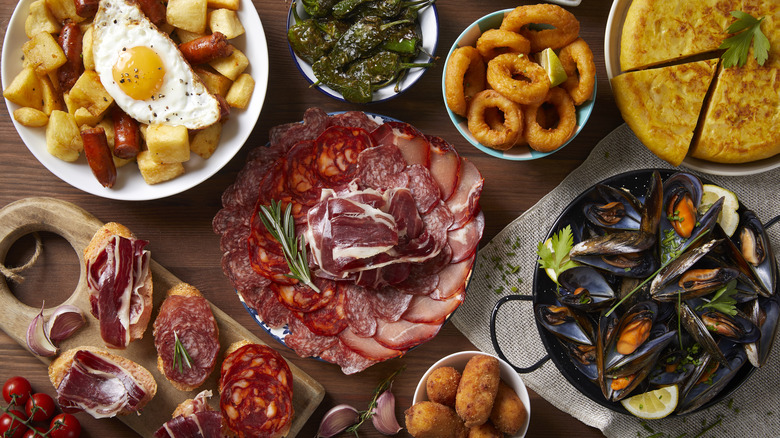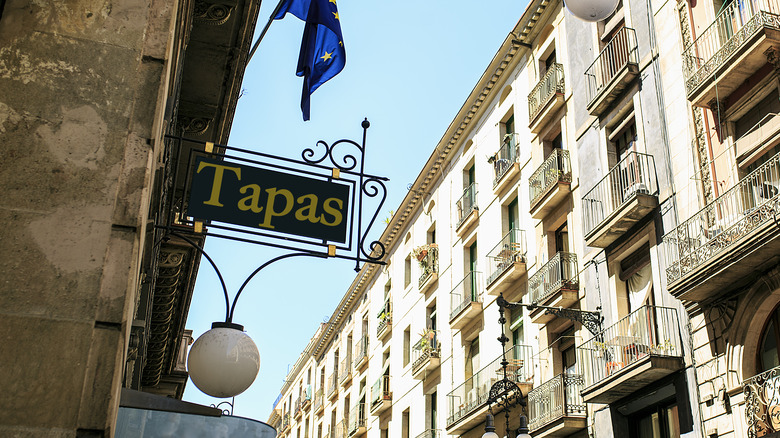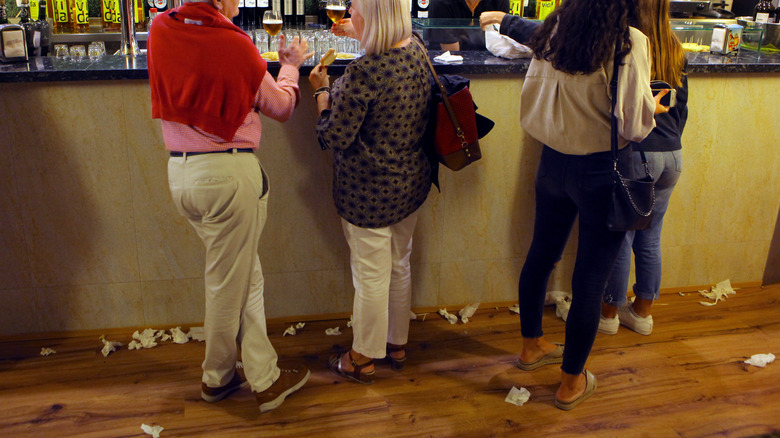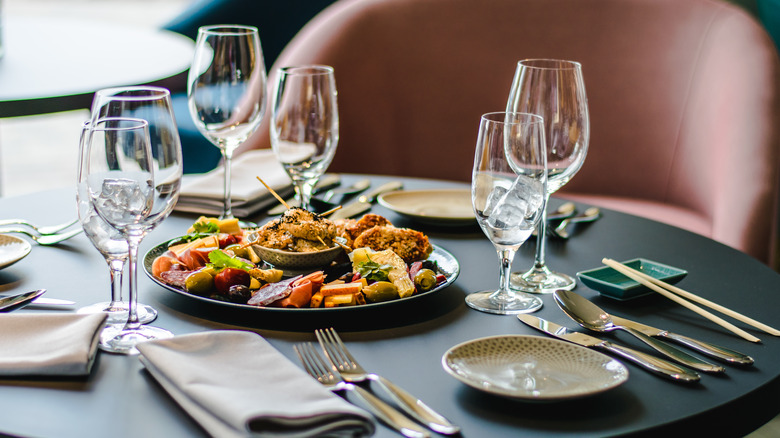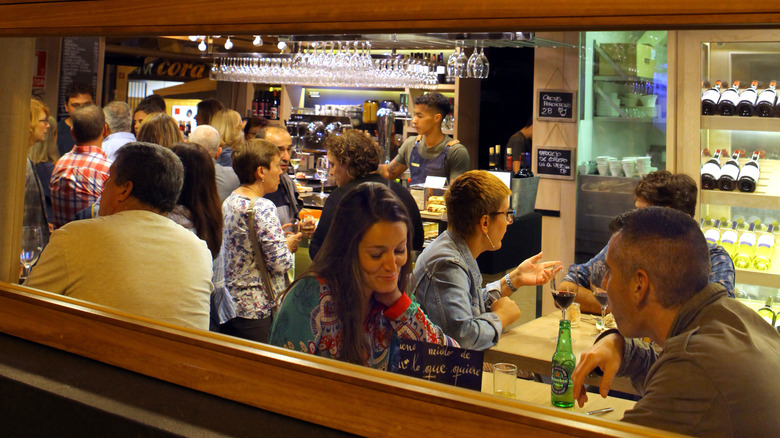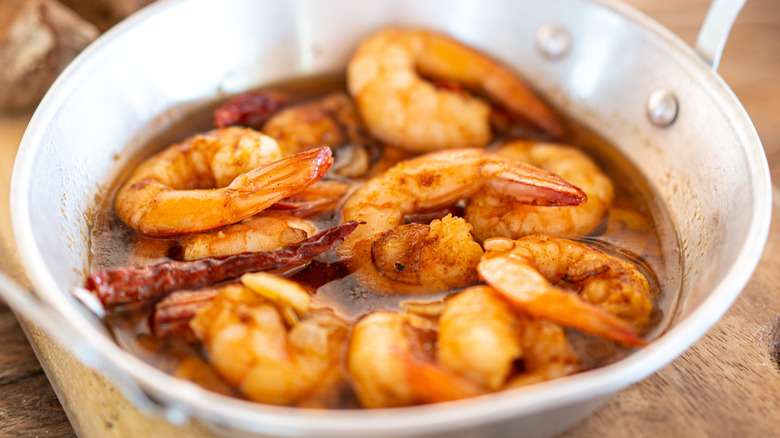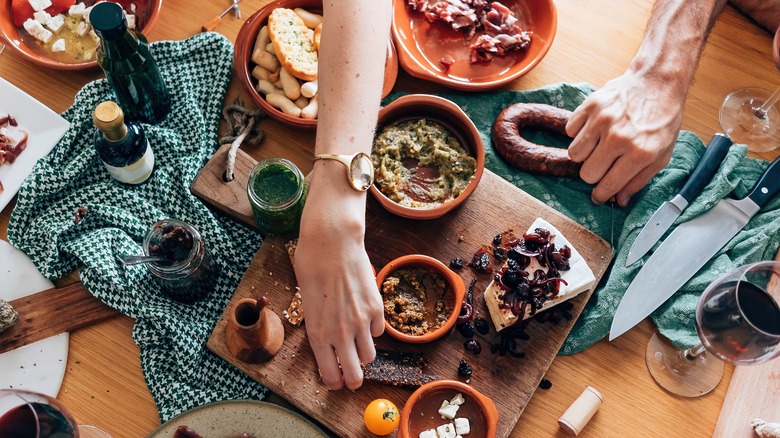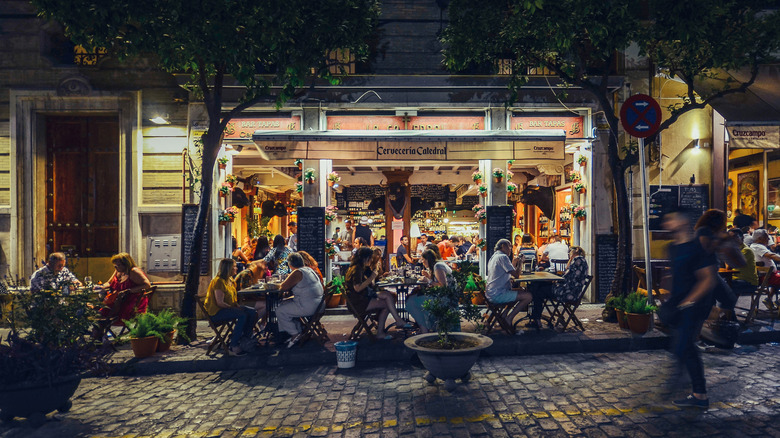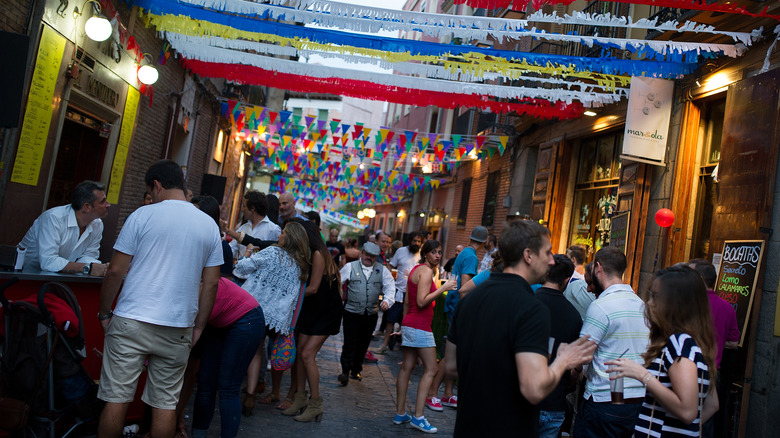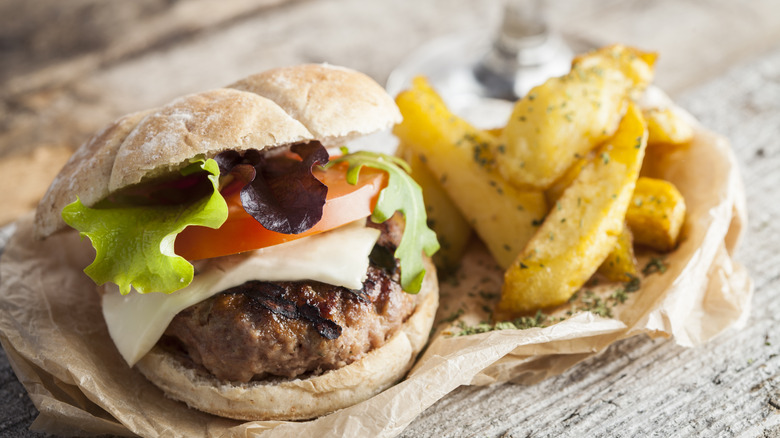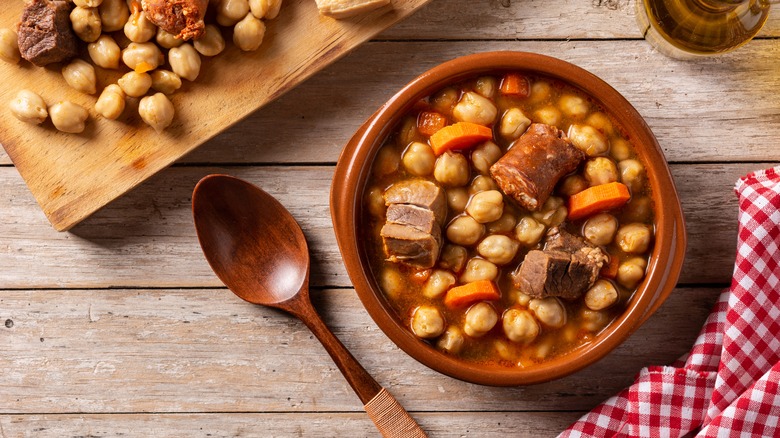14 Red Flags To Be Aware Of When Eating At A Tapas Restaurant
In Spain, you don't have to go far for a night out. The Mediterranean country has an almost incomprehensible amount of bars and restaurants, with approximately 275,000 such businesses, according to a study by the Spanish Institute for Statistics (via InSpainNews). It's a fair bet that a good amount of these establishments will serve tapas.
A quintessential Spanish dining style, tapas involves the serving of a selection of small plates and drinks. Whether enjoyed as snacks, appetizers, or a meal, tapas dining is the ultimate combination of food and socializing. But with all those bars and restaurants out there, there are bound to be a few bad eggs. Choosing a tapas restaurant can be somewhat of a guessing game.
If you're unfamiliar with tapas — and you're also on vacation in a new place — things can get challenging. How are you meant to tell the good from the bad? That's where we step in. Let's take a look at all the red flags you should look out for in a tapas restaurant, so you can give these places a wide berth.
1. It serves tapas all day long
The very nature of tapas is that it's casual. You can expect food to arrive when it's ready, instead of in a formal order. But one of the things that's slightly more rigid is when tapas is usually eaten. Generally, tapas restaurants are at their busiest during two set periods of the day: the lunch slot of roughly 1:30 to 3 p.m. and the dinner period of around 8:30 to 10:30 p.m. These times tend to correspond with general eating habits in Spain, which include these later lunch breaks and evening meals.
That's not to say that tapas can't be enjoyed at any time of the day. This dining style doesn't have to be served within those periods. But it's useful to think about what it means if a tapas restaurant is churning out dishes from sun up to sun down.
This could be an indicator that the specific restaurant isn't generally geared towards locals and is instead more tourist-focused, meaning that you don't get the most authentic experience. Additionally, eating tapas outside of these hours means you miss out on the crucial vibe of tapas dining, which is all about being in a crowded bar savoring small plates with friends and other guests. On top of that, the food being served at these all-day establishments might be less fresh. Instead, you want to look at tapas restaurants that stick to specific time windows. This indicates that a place knows what it's doing.
2. There are no napkins on the floor
In a lot of places in the world, walking into a restaurant and seeing napkins all over the floor might be a pretty big red flag. But in tapas restaurants, the opposite is true. In Spain, one particular sign of a good eater is napkins and other food detritus on the floor. This is a sign that your eatery is frequented by locals, and the more locals that eat in a bar or restaurant, the more likely it is that their food is top-quality. Thus, you should stop there for your small plates.
It's worth remembering, though, that this isn't a hard and fast rule. Some tapas restaurants, particularly slightly fancier ones, may have perfectly clean floors. Additionally, while this might be a national custom, it's useful to try and figure out whether the restaurant is good, or whether they're just not on top of their cleaning schedule.
Finally, we're not recommending that you start this tradition at businesses that don't encourage napkin-dropping. If you're unsure about whether or not it's acceptable in a restaurant to drop your napkin on the floor, it's probably best to leave it on the table. Don't be that guy.
3. It feels too fancy
Have you ever been in a restaurant and just felt totally out of place? If you have, it might be because you've inadvertently wandered into a fine dining establishment when all you wanted was a burger. Don't worry, we've all been there. But while those restaurants have a time and place, when it comes to tapas, if things feel a bit uptight, it's probably not right.
It's important to remember that tapas, by its very nature, is casual and quick. The eating style emerged as a way to eat some small bites before you go on to your main meal, over a drink and some good conversation. As a result, tapas are often eaten almost on the fly. You'll dine at a table if you can get one. But if not, you can eat tapas propped up against the bar, before heading to the next place. This convivial and fast-paced atmosphere is what makes tapas so special.
But if the restaurant you've just walked into has spread-out tables, tinkling classical piano music, and hushed conversations, they aren't embracing the true soul of the dining style. Skip that place and head to that crowded bar down the street. You'll have a better time.
4. There aren't any locals in the restaurant
If you're anything like us, one of the main reasons to travel is to try out cuisines from around the world. But what good is doing that if you're not eating where the locals eat? Figuring out where nearby citizens dine is a great way to sample the culinary delights of different cultures, including Spanish tapas. What's more, these places are less likely to be overpriced, so the small plates you order aren't going to break the bank.
However, finding local spots isn't easily done — as anyone who's ever been traveling and ended up in a McDonald's knows. One of the best ways to do this is just to ask around. Check with residents for recommendations of the most authentic tapas places. Specify that you're looking for tapas places off the beaten path. Additionally, you can use Google Maps. The reviews of nearby restaurants on this website may be more likely from locals, compared to those on websites like Tripadvisor.
5. Products are of poor quality
Restaurants live and die by the standard of their food. That standard starts with top-quality ingredients. With tapas restaurants, one key red flag is if the food they're serving looks like it's been made with lower-quality products.
Even a simple dish like patatas bravas needs good-quality potatoes and paprika to shine. For dishes like gambas al ajillo – which place a key ingredient like shrimp center-stage — if that ingredient isn't excellently sourced, it's not going to yield great results.
But how do you figure out which products are good or not? You'll have to do so differently for each dish. For recipes that contain jamón ibérico, for example, you're looking for meat with a strong seam of fat and gentle marbling throughout the flesh. Any prawns or shrimp used in dishes should have firm flesh, a bright color, and not taste too salty when you eat them. Understandably, it can be tricky to figure this all out before it's too late, when you realize you're eating food that isn't amazing. If in doubt, ask a waiter about how their food is sourced.
6. You aren't encouraged to order a drink first
One of the origin stories of tapas is concerned with the drinking habits of the 13th-century ruler King Alfonso X. Allegedly, while the Spanish king was recovering from a period of ill health, he was prescribed wine as a remedy. To stop himself from getting too drunk, he ate little bites of food with the alcohol and found that it worked. Soon, he proposed that everyone should do the same.
The reason we discuss this here is that tapas is intrinsically linked to drinking; the original point of the eating style was to offset drunkenness. So, if you don't have a drink in your hand while you're eating, is it really tapas?
It follows that, if the restaurant that you're eating in doesn't take your drink order first, it could be a bad sign. In Spain, classic tapas restaurants always serve drinks first, as this gives your party more time to choose what you want to eat. Additionally, in some restaurants, you'll be served a complimentary tapa with the drink you order to whet your appetite. If you're being rushed into food service it could be an indicator that they want you out fast — which is never a nice feeling.
7. It has food photos and English translations on the menu
In a lot of holiday destinations, there's understandably a lot of tourism. But slipping into a tourist-focused restaurant is a nearly guaranteed way to end up with a meal that isn't concerned with making authentic tapas.
While it can be tricky to figure out exactly which restaurants are aimed at tourists and which aren't, there's one thing that gives them away: The picture menu. If the restaurant you're considering has enticed you over by blown-up pictures of their food — usually laminated and mounted on a placard outside it — it's best avoided. This is a sign that you're in the heart of tourist land. As such, the food may be hastily prepared, low-quality, or not authentic.
Another bad sign is if the menu you're looking at is written in English. But it's worth stating that this particular red flag isn't an exact science. Many tourist-specific restaurants have incredible food. These English-language menus may just be there to increase accessibility.
8. People aren't sharing plates
One of the biggest warning signs about a tapas restaurant is if people seem a little selfish. Tapas culture is all about sharing; passing each plate around so that everyone gets a bite of what's on offer. This is in keeping with the social vibe of tapas in general, which is a form of eating that's best enjoyed with good friends, good drinks, and good conversation.
But if people aren't sharing their food at the restaurant you've just wandered into — and instead sticking with one plate each — it could be a red flag. This doesn't necessarily mean that the food that people are eating isn't good. But it could be a sign that the restaurant hasn't nailed the feeling of what a tapas restaurant should be: a crowded, communal experience that feels generous and bustling. If you've come all this way to get tapas, you want the full feeling of it, right? Head next door, to that bar where people are standing elbow-to-elbow, and make some new friends.
9. It's not busy at the usual times
Spanish mealtimes are typically later. Lunch usually begins around 2 p.m. and dinner really starts to kick off around 9:30 p.m. While you might think that this is down to a laid-back national attitude, the later mealtimes of Spain are partially due to a peculiarity in time zones. The Spanish clock was nudged forward during World War II – to have the same time zone as Germany — and never changed back.
An easy way to spot a tapas restaurant that's not in keeping with the national mood is if it's busy at the wrong times. Tapas joints that fill up during mealtimes more familiar to visitors from the United States should be avoided. Take this as a sign that these businesses are meant for tourists. Instead, it's far better to wait out your evening meal until a later time, and then head to a busy-looking place. That way, you're far more likely to get the best food and the best vibe.
10. It doesn't neighbor any other tapas bars
Finding a tapas bar in the middle of nowhere might have you feeling like you've won the jackpot. But it's somewhat likely that this out-of-the-way establishment may not be up to scratch. To find the best tapas bars, you need to go where the action is. Top-quality tapas restaurants are normally clustered together, on the same street or in the same neighborhoods.
This is because of the way that tapas are usually enjoyed, which is a multi-stage affair. Customers will head to one bar, have a drink and a few bites to eat, and then hop to the next one. Tapas restaurants capitalize on this conviviality, placing their establishments next to each other. While tapas bars that aren't in the heart of the action can of course have good food, you might be missing out on a more fun and conveniently-located night if you go elsewhere.
11. The restaurant serves multiple cuisines
It can be hard to pick what you want for dinner. That's why, if you're vacationing in Spain, you might feel comforted by restaurants that have options other than tapas. You may be tempted to think that a multitude of options means more for you to choose from. Additionally, you could think that if a restaurant has multiple different cuisines, then its chefs must be more skilled.
Well, we think not. In Spain, the emphasis is not on variety, but on a few dishes done well. Even with tapas restaurants, which specialize in offering different small plates, it's advisable to look out for places that offer a moderate amount of these dishes. By doing so, you're more likely to be eating in a place where the owners have focused on getting the dishes they offer just right, instead of trying to appeal to the broadest audience possible. If the tapas bar that you are considering dining at also has burgers, fries, tacos, and sushi — take this as a red flag. It's probably focusing on quantity instead of quality, and you should skip it.
12. The classic tapas dishes are cooked incorrectly
Tapas can refer to pretty much any small plate of food served with a drink. But there are some all-time classics that you're likely to find in most tapas places. Tortilla Española, pimientos de Padrón, patatas bravas, and croquetas are all typical tapas dishes that diners know and love. But if those plates, which pretty much everyone knows, aren't being prepared properly, you should not dine at that particular business.
Unless a business is purposefully trying to put a twist on these classic dishes, a popular tapas recipe cooked incorrectly is a clear sign that the place isn't serving up quality food. It may also be an indicator that the chefs don't know the specifics of what each dish constitutes.
Take croquetas, an all-time favorite tapas dish. These small golden nuggets of food look similar to both French croquettes and Italian arancini. But although there are similarities between all of the recipes, Spanish croquetas must include a deep-fried béchamel sauce. If the bar you're eating in is advertising classic croquetas and then serving something different — perhaps without a béchamel center — it's a sign that these dishes may be made assuming that their patrons won't be able to tell the difference. This is a major red flag, in our book.
13. It doesn't cater to the region's specialties
Tapas isn't the same wherever you go. In each area of Spain, there are expected recipes and dishes, thanks to the traditional foods of the region. Tapas found in Catalonia may feel a little more French in style, thanks to the region sharing a border with France. In Catalonia, you may find tapas dishes that feature herbs and garlic-based additions like aioli. Andalusia, on the other hand, tends to rely more heavily on seafood and olive oil-based dishes. In more central regions of Spain, you'll find meat, cheese, and stews on the menu.
Thanks to the cherished culinary specificities of each region, you can expect tapas restaurants in each area of Spain to champion these. If they don't — and the place you're in seems to be serving up more generic fare — it could be a red flag. This might be an indicator that the restaurant doesn't have good connections with local suppliers. Alternatively, it could be another big indicator that the establishment is setting its sights on the tourist market. As the whole point of traveling around is to try out the best local food — well, for us, anyway — make sure you're looking for places that offer regional dishes.
14. The wait staff won't give recommendations
If you go out for tapas, you should expect to have a conversation or two. It's in the very nature of the experience, which is all about socializing while munching on some inviting plates. But the chatting shouldn't just be with your companions. The wait staff in the restaurant you're in are probably the best people to talk to, mostly because they know what's good and what's not in their restaurant.
But if the front-of-house staff are reluctant to chat, this could be a sign of what's coming to your table. Servers are understandably busy and shifts can be stressful, so it's good not to take it personally if they don't have time to talk. But if waiters straight-up refuse to tell you their recommendations, that could scream the fact that they don't rate the food that they're serving very highly. As well as this, asking staff members what they like or recommend is a fairly common practice in Spain. If they're not up to tell you, it could indicate that you're not eating in a joint that locals frequent.
